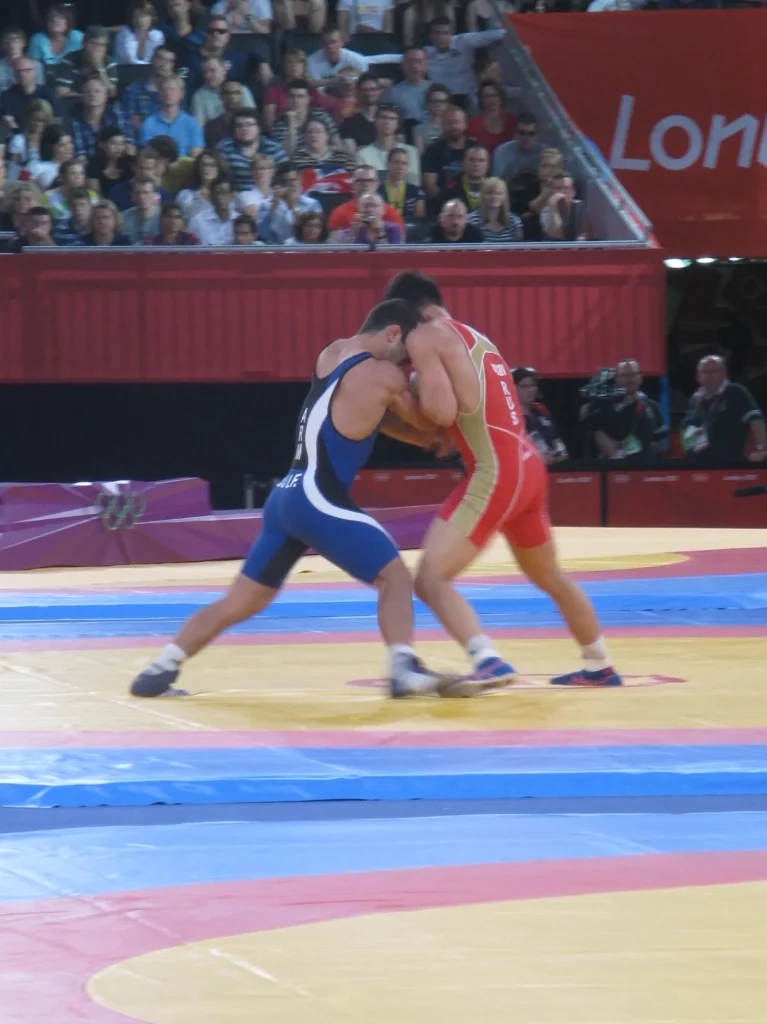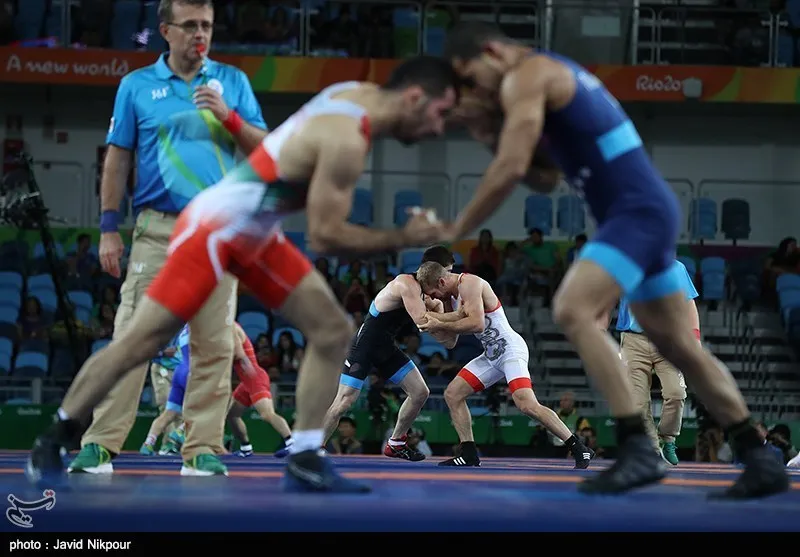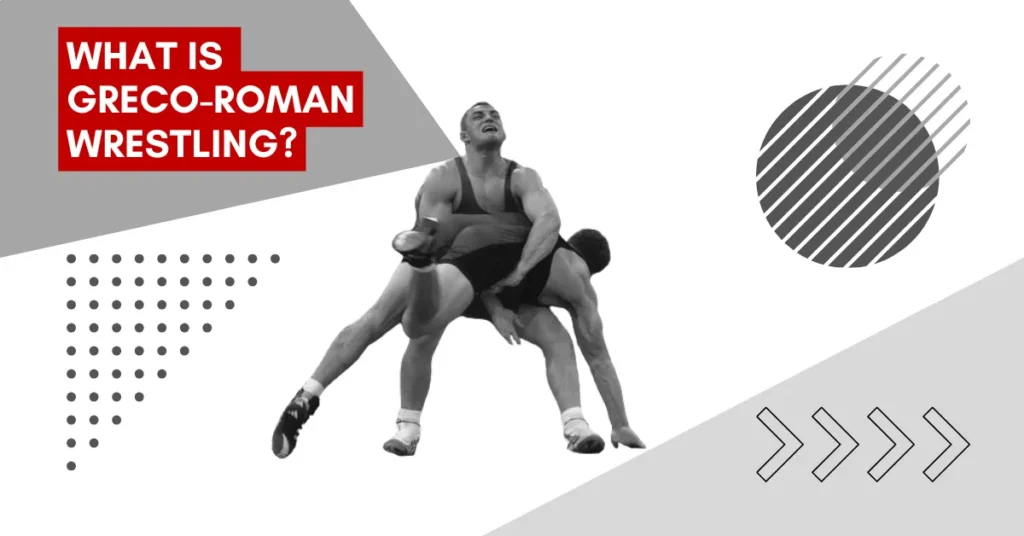Did you know that Greco-Roman wrestling, an Olympic wrestling style, has a history dating back to the first modern Olympic Games in 1896? This ancient and revered sport has captivated audiences worldwide with its unique techniques and thrilling displays of athleticism. Let’s explore the essentials of Greco-Roman wrestling, its rich history, and the techniques that make it a truly awe-inspiring sport.
This ancient sport, which originated in Europe and is currently a global phenomenon at the Olympics, concentrates on throws, lifts, and strategic holds, excluding leg attacks. Come discover the special fusion of power and skill that characterizes Greco-Roman wrestling, where competitors showcase their impressive upper body strength in compelling displays that make every match an exciting spectacle.
Table of Contents
Key Takeaways
- Greco-Roman wrestling is an Olympic wrestling style that focuses on throws and forbids holds below the waist.
- It has a rich history and has been a part of every edition of the summer Olympics since 1904.
- Wrestlers primarily rely on throws to execute scoring takedowns in Greco-Roman wrestling.
- Greco-Roman wrestling differs from freestyle wrestling in terms of rules and techniques.
- The sport is divided into different weight classes, allowing wrestlers to compete against opponents of similar weight.
The History of Greco-Roman Wrestling
Greco-Roman wrestling has a fascinating history that spans centuries and connects to ancient civilizations. Its origins can be traced back to the Mediterranean region, particularly the ancient Greek Olympics.
The style we know today as Greco-Roman wrestling was developed by Jean Exbrayat, a Napoleonic soldier, in the 19th century. Exbrayat established a set of rules that distinguished Greco-Roman wrestling from other forms of wrestling. These rules forbade the use of holds below the waist as well as painful holds, creating a unique style focused on throws and upper body techniques.
“Greco-Roman wrestling is a style marked by its emphasis on throws and its prohibition of holds below the waist. It has a rich history dating back to ancient times and has evolved into a popular Olympic sport.”
The style gained popularity throughout Europe and eventually became one of the first wrestling styles to be registered at the modern Olympic Games in 1896. Since then, it has been a regular event at the Olympics, showcasing the skills and strength of wrestlers from around the world.
Over the years, Greco-Roman wrestling has produced many notable champions who have left their mark on the sport. Countries such as the former Soviet Union, Bulgaria, Turkey, and Sweden have enjoyed great success in this Olympic discipline, solidifying their reputation as powerhouses in the wrestling world.
Greco-Roman wrestling’s historical significance, combined with its status as an Olympic sport recognized by the International Wrestling Federation, firmly establishes it as a beloved and revered wrestling style.
| Year | Host City | Gold Medalist |
|---|---|---|
| 1896 | Athens, Greece | Carl Schuhmann (Germany) |
| 1908 | London, United Kingdom | Anders Ahlgren (Sweden) |
| 1920 | Antwerp, Belgium | Ivar Johansson (Sweden) |
| 1956 | Melbourne, Australia | Yoshiro Fujita (Japan) |
| 1988 | Seoul, South Korea | Juergen Schult (East Germany) |
As the Olympic Games continue to showcase the best wrestlers in the world, Greco-Roman wrestling will undoubtedly remain a highlight of the competition, maintaining its status as one of the most distinguished wrestling styles in history.
Rules and Techniques of Greco-Roman Wrestling
Greco-Roman wrestling adheres to a set of rules and techniques that distinguish it from other amateur wrestling styles. The objective is to either pin both of the opponent’s shoulders to the mat or score more points within a given time frame. Holds below the waist are strictly prohibited, and wrestlers primarily rely on throws to execute takedowns and gain points. Points are awarded for various moves, with the difficulty level determining the number of points earned. A grand amplitude throw that ends in a ‘danger position’, exposing the opponent’s back to the mat, can earn a maximum of five points.
Points can also be earned through reversals and if the opposing wrestler commits an infraction. The scoring system in Greco-Roman wrestling is cumulative, meaning points are tallied throughout the match. A wrestler can secure victory by achieving technical superiority or building up a substantial lead over the opponent.
Rules of Greco-Roman Wrestling
The following table provides an overview of the key rules and regulations in Greco-Roman wrestling:
| Rule | Description |
|---|---|
| No Holds Below the Waist | Holds or grips directly below the waist are strictly prohibited. Wrestlers must rely on upper-body techniques and throws to execute takedowns. |
| Scoring Points | Points are awarded for various moves, with the difficulty level determining the number of points. The cumulative scoring system tracks the wrestler’s accumulation of points throughout the match. |
| Grand Amplitude Throw | A maximum of five points can be earned through a grand amplitude throw that ends in a ‘danger position’, where the opponent’s back is exposed to the mat. |
| Reversals and Infractions | Points can be earned through successful reversals and if the opponent commits an infraction, such as grabbing clothing or retaliating with an illegal move. |
| Technical Superiority | A wrestler can secure victory by achieving technical superiority, which occurs when they build up a certain lead over the opponent. |
Greco-Roman wrestling combines skill, strategy, and athleticism within the structured framework of its rules and techniques. By understanding and mastering these principles, wrestlers can effectively compete and excel within this historic discipline.

Weight Classes and Tournament Structure in Greco-Roman Wrestling
Greco-Roman wrestling, like many other combat sports, employs weight classes to ensure fair competition and prevent significant weight disparities. Wrestlers are grouped into different weight categories, allowing them to face opponents of similar size and strength. This creates a level playing field and enhances the competitive aspect of the sport.
In Greco-Roman wrestling, there are five main age categories: U15, U17, U20, Seniors U23, and Seniors. Each category has its own set of weight classes, and wrestlers must compete in their designated weight class. Weigh-ins are conducted before the tournament to verify that the wrestlers meet the weight requirements for their respective categories.
The tournament follows an elimination structure, where wrestlers compete in elimination rounds to determine the finalists in each weight class. The ideal number of wrestlers in each category is predetermined, and if the number is not reached, a qualification round is held to eliminate the excess participants. This ensures that only the most deserving wrestlers advance to the elimination rounds.
The elimination rounds lead to the finals, where the top two wrestlers in each weight class face off for first and second place. These matches showcase the highest level of skill and competitiveness, with the finalists battling for victory. However, wrestlers who are defeated by the finalists in earlier rounds still have an opportunity to compete for a medal.
The repechage round offers wrestlers who have lost to the finalists a chance to fight for a medal. The repechage bracket is formed by the wrestlers who were defeated by the finalists, and they compete against each other for a shot at a medal. This gives wrestlers an additional chance to showcase their skills and potentially earn a podium finish.
| Age Category | Weight Classes |
|---|---|
| U15 | 40kg, 45kg, 50kg, 55kg, 60kg, 65kg, 70kg, 75kg, 85kg, 100kg, 125kg |
| U17 | 45kg, 50kg, 55kg, 60kg, 65kg, 70kg, 76kg, 85kg, 100kg, 110kg, 125kg |
| U20 | 55kg, 60kg, 63kg, 67kg, 72kg, 77kg, 82kg, 87kg, 97kg, 130kg |
| Seniors U23 | 55kg, 60kg, 63kg, 67kg, 72kg, 77kg, 82kg, 87kg, 97kg, 130kg |
| Seniors | 55kg, 60kg, 63kg, 67kg, 72kg, 77kg, 82kg, 87kg, 97kg, 130kg |
The weight classes in Greco-Roman wrestling accommodate a wide range of body types and ensure that wrestlers have a fair chance to compete in their respective categories. From the youngest athletes in the U15 age category to the seasoned Seniors, each grouping offers a variety of weight classes to cater to wrestlers of different sizes.
The tournament structure, with its elimination rounds and repechage system, provides multiple opportunities for wrestlers to showcase their skills and determination. It creates an environment of intense competition and allows wrestlers to overcome initial setbacks and still have a chance to earn a medal.
Greco-Roman Wrestling at the Olympics
Greco-Roman wrestling has been an integral part of the Olympic Games since their historic inception in 1896. As one of the oldest Olympic sports, Greco-Roman wrestling has captivated audiences and showcased the remarkable strength and skill of its athletes for over a century.

This discipline has exclusively been a men’s event, attracting fierce competition and witnessing dominant performances from various countries throughout Olympic history.
Notable honorees in Greco-Roman wrestling include George Hackenschmidt, a legendary Estonian wrestler who won a gold medal at the 1908 London Olympics, and Aleksandr Karelin, a revered Russian wrestler who earned three Olympic gold medals during his illustrious career.
The weight categories for Greco-Roman wrestling at the Olympics offer athletes the opportunity to compete against opponents of similar weight and test their mettle in various weight classes.
| Olympic Games | Gold Medalist | Nationality |
|---|---|---|
| 1908, London | George Hackenschmidt | Estonia |
| 1988, Seoul | Aleksandr Karelin | Russia |
| 1992, Barcelona | Aleksandr Karelin | Russia |
| 1996, Atlanta | Aleksandr Karelin | Russia |
Over the years, the Olympic Games have witnessed outstanding performances, intense rivalries, and remarkable displays of athleticism in Greco-Roman wrestling. This timeless sport continues to be a highlight of the Olympic program, captivating audiences around the world with its rich history and legacy of champions.
Conclusion
Greco-Roman wrestling, with its unique techniques, rich history, and status as an Olympic wrestling style, continues to mesmerize wrestling enthusiasts around the world. This ancient sport, characterized by its emphasis on throws and the prohibition of holds below the waist, showcases the incredible skill and athleticism of its competitors.
For wrestling competitors and fans alike, understanding the essentials of Greco-Roman wrestling deepens appreciation for this revered sport. From its origins in ancient civilizations to its inclusion in the modern Olympic Games since 1896, Greco-Roman wrestling has stood the test of time. The mastery of wrestling techniques, particularly throws, is crucial to achieving success in this captivating style.
As the sport evolves and new wrestling techniques are developed, the foundations of Greco-Roman wrestling remain steadfast. Wrestlers engage in intense battles on the mat, strategically vying for dominance with upper body strength and explosive movements. The absence of leg maneuvers adds a distinctive element to Greco-Roman wrestling, requiring competitors to adapt and innovate within the confines of the rules.
Whether you participate in Greco-Roman wrestling or simply appreciate its history and spectacle, this Olympic style of wrestling is a testament to the enduring legacy of the ancient sport. From its portrayal in ancient Greek competitions to its status as a celebrated Olympic event, Greco-Roman wrestling continues to captivate, inspire, and showcase the pinnacle of human strength, agility, and perseverance.
FAQ
What is Greco-Roman wrestling?
Greco-Roman wrestling is a style of wrestling that focuses on throws and forbids holds below the waist. It is one of the Olympic wrestling styles and has been practiced worldwide since the first modern Olympic Games in 1896.
What is the main difference between Freestyle and Greco-Roman wrestling?
The key difference is in allowed holds. Greco-Roman wrestling permits holds only above the waist, while freestyle wrestling allows attacks on any part of the body, including the use of legs.
Can you touch legs in Greco-Roman wrestling?
No, touching the opponent’s legs in Greco-Roman wrestling is prohibited, resulting in penalties or fouls.
Is Greco-Roman like judo?
Greco-Roman wrestling and judo differ in rules and techniques. Greco-Roman focuses on upper-body clinching and throws, prohibiting leg attacks. Judo allows the use of the entire body, including leg techniques, and includes ground grappling and submissions.
What are some essential tips for Greco-Roman wrestling?
To excel in Greco-Roman wrestling, focus on mastering throws and quick positioning. Develop upper body strength and explosive movements. Familiarize yourself with the rules and scoring system and work on executing techniques with precision and efficiency.
How are weight classes and tournaments structured in Greco-Roman wrestling?
Greco-Roman wrestling is divided into different weight classes to ensure fair competition. Wrestlers weigh in before the tournament and compete only in their designated weight class. The tournament follows an elimination structure, leading to finals where the top two wrestlers in each weight class compete for first and second place. Wrestlers who lose to the finalists can compete in a repechage round for a chance to win a medal.

